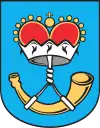Kłecko
Kłecko ([ˈkwɛt͡skɔ]; German: Kletzko, 1940-45 Klötzen) is a town in Gniezno County, Greater Poland Voivodeship, Poland, with 2,712 inhabitants (2004).
Kłecko | |
|---|---|
 Saint George church in Kłecko | |
 Flag  Coat of arms | |
 Kłecko  Kłecko | |
| Coordinates: 52°38′N 17°26′E | |
| Country | |
| Voivodeship | Greater Poland |
| County | Gniezno |
| Gmina | Kłecko |
| Established | 9th century |
| Area | |
| • Total | 9.61 km2 (3.71 sq mi) |
| Population (2006) | |
| • Total | 2,677 |
| • Density | 280/km2 (720/sq mi) |
| Time zone | UTC+1 (CET) |
| • Summer (DST) | UTC+2 (CEST) |
| Postal code | 62-270 |
| Vehicle registration | PGN |
| Climate | Dfb |
| Website | http://www.klecko.pl |
History
A Lechitic stronghold was founded in the 9th century, located in the Greater Poland region, which in the 10th century would become the cradle of the emerging Polish state. Kłecko was granted town rights probably by Duke Bolesław the Pious in 1265. It was a royal town of Poland, administratively located in the Gniezno County in the Kalisz Voivodeship in the Greater Poland Province of the Polish Crown.[1] In 1331, during the Polish–Teutonic War, the Teutonic Knights plundered and destroyed the town, and murdered its defenders.[2] A battle between the Swedish Army and Polish forces stood here on 7 May 1656 during the Deluge (Swedish invasion of Poland). The battle was an important victory for Sweden. A painting picturing the battle can be seen in the museum at the current Home of the Swedish royal family Drottningholm Palace near Stockholm, Sweden.
Second World War

During the German Invasion of Poland, which started World War II, the Wehrmacht reached Kłecko on 8 September 1939 and a battle was fought in which the town was fiercely defended by Poles.[3] The first killed defender was 17-year-old boy scout Sylwester Śliwiński.[3] After capturing the town, Wehrmacht soldiers and SS mass murdered 300 Polish civilians from the town on 9 and 10 September. The victims were chosen at random, from all males gathered in the town square and then randomly selected for execution as alleged attackers against German Army. 41% of murdered were teenagers (11 years to 16 years old), but people as old as 78 were also killed. The victims were later buried in mass graves.[4] The commanders of the Polish defense were captured by the Germans in October 1939, and then murdered in November 1939.[3] Families of the victims, 139 people, were expelled from the town in 1939.[5] The German occupation ended in 1945.
Curiosities
After Second World War Greater Poland governor called Kłecko "Wielkopolskie Westerplatte", which means, Kłecko is Greater Poland equivalent of Westerplatte.
References
- Atlas historyczny Polski. Wielkopolska w drugiej połowie XVI wieku. Część I. Mapy, plany (in Polish). Warszawa: Instytut Historii Polskiej Akademii Nauk. 2017. p. 1b.
- Strzyż, Piotr (2009). Płowce 1331 (in Polish). Warszawa: Bellona. p. 176. ISBN 978-83-11-11635-1.
- "„Wielkopolskie Westerplatte"". pojezierze24.pl (in Polish). Retrieved 12 December 2020.
- Szymon Datner "55 dni Wehrmachtu w Polsce" page 315-324
- Wardzyńska, Maria (2017). Wysiedlenia ludności polskiej z okupowanych ziem polskich włączonych do III Rzeszy w latach 1939-1945 (in Polish). Warszawa: IPN. p. 171. ISBN 978-83-8098-174-4.
- "GKS Lechita Kłecko - strona klubu" (in Polish). Retrieved 12 December 2020.